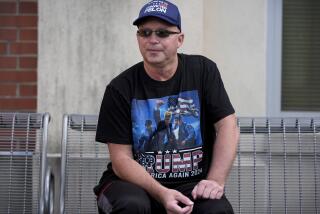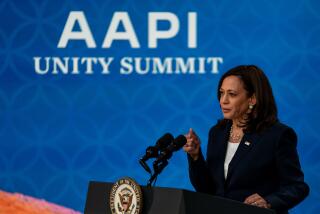The voters no one can take for granted
HIGHLANDS RANCH, COLO. — When President Bush campaigned for reelection three years ago, this community near Denver was a promising territory: a fast-growing collection of cul-de-sacs and nearly identical homes, where thousands of young families seemed open to Republican ideas.
The “exurbs,” the far-flung suburbs of Minneapolis, Cincinnati, Denver and other cities, were full of parents too busy with school, church and work to bother affiliating with either major party. GOP strategy held that, come election time, Republicans could win these voters with talk of lower taxes, stronger security and family values -- not only to help Bush, but to position the party for long-term dominance.
But talk today to Donna Howe, 49, a mother of two who backed Bush in 2004, and a dramatic setback to that plan emerges.
Like many of her neighbors, Howe is an independent voter who is frustrated by the direction of the country, nervous about national security -- and open to a Democratic candidate “with good ideas on healthcare and a reasonable plan to deal with the Iraq war.”
The same holds for Jim Tuccio, 44, who lives a few streets away and blames Republican mismanagement of the economy for strangling the mortgage company he once worked for, costing him his job.
Unaffiliated voters, who split evenly between Bush and Democrat John F. Kerry in 2004, are now looking more favorably at the Democratic Party, a reaction to Bush’s slide in the polls, the U.S. struggle in Iraq and other disappointments with GOP leadership.
It is a dramatic political development in such a closely divided electorate, and one that is likely to paint a different Electoral College map that for the last two elections was shaded Republican red in the heartland and the South, and Democratic blue in the coastal West, the Upper Midwest and the Northeast.
Strategists in both major parties believe the shift among independents was crucial to last year’s Democratic sweep of congressional and state races in a number of traditionally Republican states, such as Colorado, Missouri, Montana and Ohio.
Here in Douglas County, the state’s Democratic governor won nearly 50% of the vote last year -- a major achievement, considering that fewer than one in five voters here are Democrats and that President Bush had won overwhelmingly in 2000 and 2004.
Strategists agree that the shift foreshadows a far more complicated calculus as next year’s presidential election unfolds. Already, both major parties are examining ways to lure the increasingly important constituency, which though losing faith in Bush, is not enthusiastic about the Democratic Party. At stake are the White House and control of Congress, with competitive Senate races expected in Colorado as well as in Maine, Minnesota, New Hampshire and Virginia -- all with heavy concentrations of independent voters.
“These independents are not marching into the Democratic Party and declaring themselves Democrats, but the change is in the tilt,” said Carroll Doherty, associate director of the Pew Research Center for the People & the Press. “They are definitely leaning toward the Democrats.”
Polls show that the movement among independents is a broad phenomenon.
Surveys by Pew have found that far fewer voters now identify with the Republican Party. Where the two parties had roughly an equal hold on the electorate in 2002, now only about 35% call themselves Republicans or independents leaning toward the GOP, compared with about 50% aligning with the Democrats.
Moreover, independent voters are shifting their outlook on government, Pew found, putting them more in line with the Democratic Party in their concern about income inequality and belief in a government safety net for the poor.
Even some of the GOP’s most ardent backers -- supporters whom Bush’s campaign courted heavily in 2004 -- are less enthusiastic about the party, among them Latinos and women in suburbs and exurbs.
And holding the loyalty of evangelical Christians has become one of the most surprising problems for the Republican Party.
Support among white evangelicals neared 100% after the Sept. 11 terrorist attacks, and the White House used pastors, church membership directories and other tools to mobilize evangelicals for the 2004 election. But Bush’s support among these voters dropped to 44% in a June Pew survey, sparking concern in GOP circles that an unmotivated base would cripple the party’s efforts to compensate for losses among independent voters.
Phil and Sue Waters helped organize their suburban Denver megachurch to campaign for an anti-gay-marriage referendum on last year’s state ballot. But even these core GOP voters are feeling less excited about pitching in for the party’s candidates in 2008.
Their church, Faith Bible Chapel in Arvada, has long been a hub for Republican politics in closely fought Jefferson County. In a surprising change last year, a Democrat won the area’s congressional seat. Democrats plan to target the county next year for the open Senate seat as well as the presidential election.
On a recent Wednesday evening, after a prayer service devoted to a Bible verse about respecting the authority of God and government, the Waterses said they had lost their enthusiasm for the current authority figures in Washington, and said they were worried about next year’s election.
“I’m still a Republican, but I’m very close to being an independent,” said Phil Waters. “I’m closer to the middle than I used to be because of the way the Republicans have screwed things up.”
Democrats, who chose Denver for their national nominating convention, are trying to build on such momentum. But party strategists recognize that they must proceed gingerly to win independent voters.
If 2004 was the year of the red-meat message to the party base, 2008 is shaping up as a time for the soft sell to the middle.
In Arapahoe County, another suburban Denver battleground, a group called Democrats Work is trying to woo unaffiliated voters by cleaning parks, building school playgrounds and performing other community service projects. The goal is to show that “Democrats are more like your friends and neighbors, not necessarily the people in Washington,” group founder Thomas Bates said.
Some Democrats tried the soft-sell strategy in last year’s elections. Rep. Ed Perlmutter, who took over a GOP seat in Colorado’s 7th Congressional District, highlighted his moderate views on issues important to swing voters. In one direct-mail piece, he cited his daughter’s epilepsy as his “personal” reason to back stem-cell research. The independent voters “call the shots,” said Perlmutter, who stalks unaffiliated supporters at area supermarkets through his twice-monthly Government at the Grocery sessions.
Democratic analysts say the 2006 election underscored the importance of downplaying partisanship and campaigning to the middle.
An analysis of 30 competitive races found that the Democratic Party’s voter turnout was strong, due in part to Republican troubles and unusual Democratic unity. But turnout of the hard-core GOP base was just as good. The findings suggested that Democrats could not hope to win without a majority of independent voters.
“Turnout was a neutral factor in ‘06,” said Mark Gersh, director of the National Committee for an Effective Congress, which conducted the analysis for House Democratic leaders. “What gave us victories was garnering votes among moderates and independents.”
The same realization is dawning on some Republicans, who concede that they have not fielded candidates with enough appeal to unaffiliated voters -- at least in Colorado. Even when Bush won the state in 2004, the GOP lost a U.S. Senate seat and ground in the state General Assembly.
“The ideal candidate is not necessarily a party activist,” Dick Wadhams, state GOP chairman, said.
For the most part, independent voters will watch from the sidelines as party members choose their presidential nominees in the coming months. Then, the nominees will probably pivot from partisanship to the middle -- and any outcome is possible.
Unaffiliated voters fed up with Bush, for example, might be willing to back former New York Mayor Rudolph W. Giuliani or former Massachusetts Gov. Mitt Romney, two Northeastern Republicans with a history of reaching beyond the party base.
Or some independents, like Howe, the Highlands Ranch mother, may be ready to vote for a Democrat. In Howe’s case, that’s unless the nominee is Sen. Hillary Rodham Clinton of New York, whom she faults for staying with President Clinton after his affair with a White House intern.
“I have no idea who I’ll vote for,” she said from her porch in the shadow of the Rocky Mountains.
She said she wanted someone to fix the high cost of healthcare and worried about how her college-student daughter would afford it in the future. “What’s she going to do when she’s not under our plan?” Howe asked.
Tuccio, the former mortgage account executive, long viewed the GOP as the party of affluence and strength. After losing his job, he has doubts.
“I’ve been getting let down, but I don’t see the wealthy getting hurt,” he said in the foyer of his home.
Tuccio said he did not know whom he would vote for next year either. As he searches for a new job, thinking about the election “is probably the last thing on my list of things to do.” But, he said, “I know it’s important.”
When the campaigns come calling, Tuccio will be listening -- and neither side can take him for granted.
peter.wallsten@latimes.com
More to Read
Sign up for Essential California
The most important California stories and recommendations in your inbox every morning.
You may occasionally receive promotional content from the Los Angeles Times.










